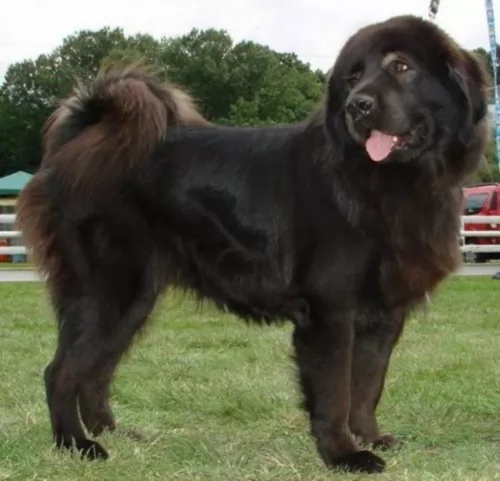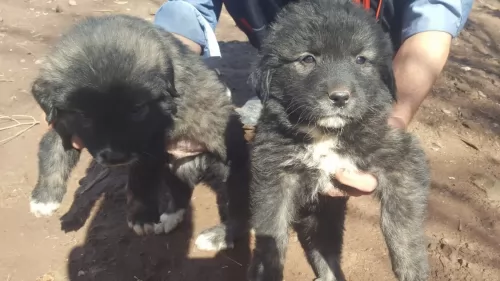 Petzlover
PetzloverBakharwal Dog is originated from India but Double-Nosed Andean Tiger Hound is originated from Bolivia. Bakharwal Dog may grow 16 cm / 7 inches higher than Double-Nosed Andean Tiger Hound. Bakharwal Dog may weigh 7 kg / 16 pounds more than Double-Nosed Andean Tiger Hound. Bakharwal Dog may live 3 years less than Double-Nosed Andean Tiger Hound. Both Bakharwal Dog and Double-Nosed Andean Tiger Hound has almost same litter size. Bakharwal Dog requires Moderate Maintenance. But Double-Nosed Andean Tiger Hound requires Low Maintenance
 The precise origin of the large Bakharwal Dog is undocumented. It is believed the breed originated from the Tibetan Mastiff, the Molosser, the Tuvan Sheepdog and others. It is an ancient working breed where it has been bred for many centuries by the Bakarwal and Guijar tribes. The dog is thought to be the rarest of all the ancient herding breeds.
The precise origin of the large Bakharwal Dog is undocumented. It is believed the breed originated from the Tibetan Mastiff, the Molosser, the Tuvan Sheepdog and others. It is an ancient working breed where it has been bred for many centuries by the Bakarwal and Guijar tribes. The dog is thought to be the rarest of all the ancient herding breeds.
The Bakharwal is an indigenous breed of Himalayan origin, being bred exclusively by those wanting a strong, brave dog to protect their livestock. Today Jammu and Kashmir in North India is predominantly the stronghold of this breed.
The Bakharwal dog today as we know it is a muscular dog, tall and powerful and with a thick, fluffy coat. He has remained a livestock guardian or herding dog for the people occupying the Pir Panjal mountain ranges for centuries.
Unfortunately the breed’s rarity as well as his lack of recognition has put this attractive dog in danger of becoming extinct, and in fact steps have been taken to have the dog listed as an endangered species. The females only produce small litters of between 1 to 3 puppies. There are currently no breeding clubs for the Bakharwal Dog and the other sad aspect is that the breed isn’t recognized by any of the major kennel clubs.
This is truly a rare breed of dog with his double nose. He hails from Bolivia.
Twentieth century reports of this rare feature include one report of a certain Percy Fawcett in 1913 already. This report received wide press coverage in 2006. There were photographs of this unique dog breed and they were distributed in the leading press outlets, with some people thinking that this was just a genetic abnormality.
However it soon proved that this wasn’t an abnormality but part of the breeds unique features, and these dogs can be seen around Bolivia and Trinidad.
It is believed that this dog is descended from the Pachon Navarro, a type of Pointer dog believed to have been brought to Central- and South America in the 16th century. Today, no kennel club recognizes the dog.
 This dog is large, heavily boned, muscular and with a deep chest. They’ve got large heads and a thick, muscular neck. The nose is black, the almond-shaped brown or amber eyes gentle while the ears are medium sized and drooping. The tail is long and bushy and mostly curls over the back of the dog. Their thick coats are available in a number of colours such as cream, tan, white, black and piebald.
This dog is large, heavily boned, muscular and with a deep chest. They’ve got large heads and a thick, muscular neck. The nose is black, the almond-shaped brown or amber eyes gentle while the ears are medium sized and drooping. The tail is long and bushy and mostly curls over the back of the dog. Their thick coats are available in a number of colours such as cream, tan, white, black and piebald.
The Kashmiri Sheepdog has long legs and although a number of sizes exist, the regular height of the dog is roughly 61 to 76 cm.
Known also by several other names such as the Kashmir Mastiff, Kashmir Sheepdog or Bakarwal Mastiff, this dog is well known for his ferociousness, and guarding his human family is taken seriously. His courage knows know limits and he is both protector and friend, a loyal and devoted companion.
He forms a strong bond with his human family and is good natured with well behaved children who have been taught to treat animals with kindness. Caution should always be practised with small children as this is a large dog. He is playful, social and adaptable with his human family but won’t take kindly to other pets. Socialization and training are important for this strong-willed dog.
The Double-nosed Andean Tiger Hound is a medium to large sized pure bred dog known specifically for this unique feature – the double nostril divided by a skin and fur band.
He stands at roughly 48 – 60cm and weighs 20 – 29kg. The dog has floppy ears or semi-erect ears with short limbs and a long tail.The coat of the dog is short and silky and it can be brown and white or black, grey and white or he can be a mixture of several of these colors.
Even though the dog’s name - Andean Tiger Hound - might make people think it is similar in character to a tiger, it is actually a sweet natured dog with a gentle nature that loves being close to its human family.
It lives peacefully with children and pets in the home. It is a brave, alert dog who makes a good watchdog. He is an energetic dog and will require regular exercise such as long walks. As with all dogs he can benefit with training and socialization and being an intelligent breed, he is actually easy to train.
 Bred exclusively as a livestock guardian dog, the large Bakharwal is a steadfast, loving, brave guardian. He is good with people of all ages and will protect his human family with his life.
Bred exclusively as a livestock guardian dog, the large Bakharwal is a steadfast, loving, brave guardian. He is good with people of all ages and will protect his human family with his life.
To this day the breed has a strong herding and guarding instinct, and because he is a large breed with herding instincts, he won’t be suited to apartment living. He needs a good sized garden to run in and will require exercising to stave off frustration and boredom.
Look after your Bakharwal well, especially as there aren’t many of them left. Loved, nourished and cared for, he’s just waiting to make you part of his ‘flock’ and in exchange he’ll be your loyal and devoted friend who will protect you with his life.
This medium sized dog with the double nose is unusual in that respect, but he is no different from most other dogs when it comes to making a wonderful pet.
Loving, loyal, gentle, easy to please, amicable and intelligent, the Double Nosed Andean Tiger Hound guarantees to make you an excellent pet as he has so many of the desired characteristics of a good friend.
 Your Bakharwal puppy will need to see the vet for a complete check up and to receive his puppy vaccinations. These innoculations immunize your puppy from hepatitis, distemper, leptospirosis, parvovirus and parainfluenza.
Your Bakharwal puppy will need to see the vet for a complete check up and to receive his puppy vaccinations. These innoculations immunize your puppy from hepatitis, distemper, leptospirosis, parvovirus and parainfluenza.
As he grows older, you’ll need to keep his teeth free from dental plaque by using a special dog toothbrush and toothpaste.
Ticks and fleas – speak to your vet about the most effective way to treat these parasites. heartworm – this is important if your dog is exposed to lots of mosquitoes. Heartworm infestations are potentially deadly. spaying and neutering is important at 6 months of age to protect your pet from unwanted puppies and disease.
The Double nosed Andean Tiger Hound, with good care, can reach 12 to 15 years of age.
Every dog has common dog ailments to contend with and some of these your dog might be susceptible to are -
Atypical disease to look out for as your dog grows older. It can be heartbreaking to watch your bet battling to walk and battling to get up from lying down.
This is a disease with dogs that accounts for almost 50% of deaths in pets. It is a killer and you want to be looking out for drastic weight loss and lumps and get your pet to the vet.
This is a respiratory infection and it can be easily be passed from one dog to the next. Your dog will have a raspy cough and will be lethargic too.
This can cause weight loss in your pet and he can also have a swollen stomach and be lethargic.
Anything can cause your dog to have an allergy, whether it is fleas or ticks or even food. Common allergies can be treated by changing some of the things you believe could be aggravating your pet.
Remember that a healthy, balanced diet and good exercise are important for keeping your pet healthy and ensuring longevity.
 The coat of the Bakharwal Dog is thick, flat and of medium length and he is a relatively low maintenance dog. Brushing the dog’s coat twice a week will be adequate to remove loose hairs, although professional grooming can be a good thing as the density of the coat makes trimming the coat a necessity. The eyes, ears, teeth, and nails of the Bakharwal Dog should also be examined regularly just to ensure no health problems develop.
The coat of the Bakharwal Dog is thick, flat and of medium length and he is a relatively low maintenance dog. Brushing the dog’s coat twice a week will be adequate to remove loose hairs, although professional grooming can be a good thing as the density of the coat makes trimming the coat a necessity. The eyes, ears, teeth, and nails of the Bakharwal Dog should also be examined regularly just to ensure no health problems develop.
Bakharwal puppies from 8 to 12 weeks will require meals 4x a day. From 6 months on he can start having 2 meals a day. Top-quality dry- or wet dogfoods will guarantees balanced nutrition, and speaking to your veterinarian will give you an idea of what is best for your canine friend. To ensure your dog doesn’t suffer with a dry, scratchy skin, remember to include raw- and cook meat into his food. Protein is an essential ingredient for the health of your dog. Always ensure clean, cool water is available and wash food- and water bowls regularly.
Make sure your Bakharwal Dog gets plenty of exercise every day to maintain good health. Take him for walks to give him new sounds, smells and sights.
Feed your pet a quality diet – either from the top-range commercially manufactured foods or home-made food such as cooked rice, vegetables and chicken.
Steer well clear of over-feeding your pet as this can negatively affect your pet’s health in many ways.
Ensure your pet is always sheltered from the weather and that he has both sun and shade.
Your Double Nosed Andean Tiger Hound is an energetic dog and you want to walk him and make sure that he gets regular exercise to keep fit, lean and healthy.
Dogs are social creatures and to stick him in your back yard without any interaction with you is enough to make him ill and to take all the spirit out of him. Rather don’t get a pet.